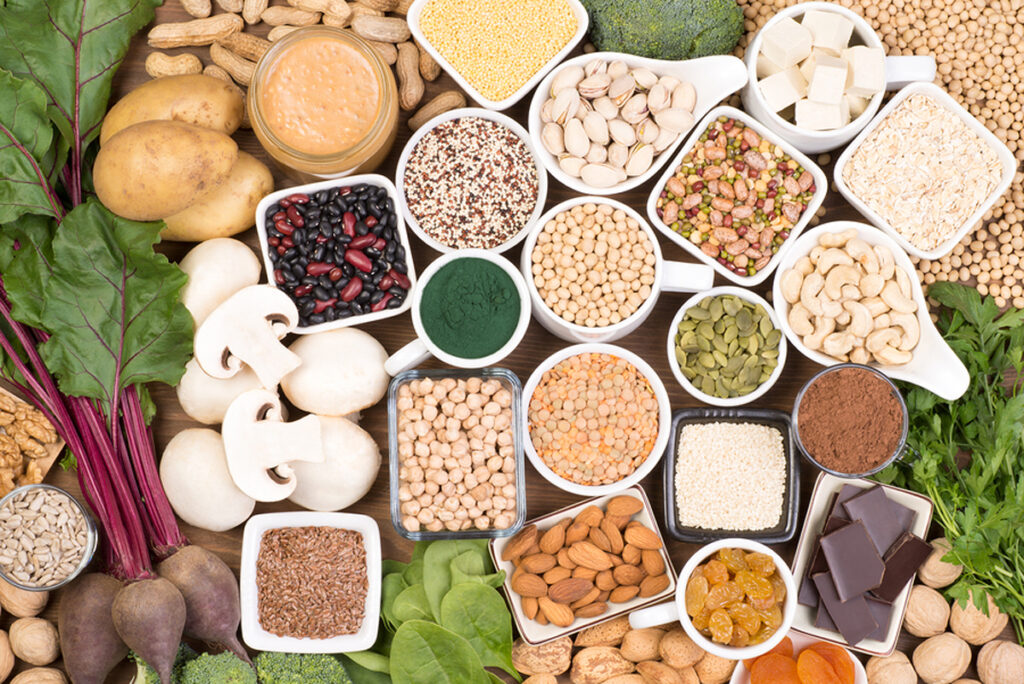What is iron?
Iron is a mineral that occurs naturally in many foods, is added to certain foods, and is available as a dietary supplement. Iron is a key component of hemoglobin, a red blood cell protein that carries oxygen from the lungs to the tissues. As a component of myoglobin, another protein that provides oxygen, iron supports muscle metabolism and healthy connective tissue. Iron is also essential for the physical and neurological development, cell function, and synthesis of certain hormones.
Hemic and Non-Hemic Iron:
Factors affecting iron absorption
➕ Enchanters' (Affect positive iron absorption )
- Ascorbate
- Citrate
- Some aminoacids
- Fish, meat , poultry
➖ Antagonists (heavy metals may share the iron intestinal absorption pathway )
- lead, cobalt, strontium, manganese, zinc
➖ Inhibitors (Affect negative iron absorption )
- phytate (beans. nuts, seeds)
- Calcium and Proteins from milk
- Polyphenols (Fruits, Vegetables)
How much iron do we need per day?
According to the National Institutes of Health, the recommended daily allowance for iron depends on age and gender.

| Age | Male ♂ | ♀ Female |
|---|---|---|
| 0-6 months | 0.27 mg | 0.27 mg |
| 7-12 months | 11 mg | 11 mg |
| 1-3 years | 7 mg | 7 mg |
| 4-8 years | 10 mg | 10 mg |
| 9-13 years | 8 mg | 8 mg |
| 14-18 years | 11 mg | 15 mg |
| 19-50 years | 8 mg | 18 mg |
| 51 years and above | 8 mg | 8 mg |
Foods high in iron
Plant Origin

200 gr boiled lentils ( 1 cup)
6.59 mg | 230 kcal

100 gr tofu
5.4 mg | 120 kcal

200 gr white beans (1 cup)
5.08 mg | 254 kcal

1 cup boiled chickpeas (164 gr)
4.74 mg | 270 kcal

1 cup boiled spinach (180 gr)
3.72 mg | 40 kcal

28 gr dark chocolate 70-85% cocoa (4 squares)
3.37 mg | 170 kcal

1 cup boiled peas (160 gr)
2.5 mg | 134 kcal

10 gr cocoa (2 tablespoons)
1.5 mg | 23 kcal
Animal Origin

200gr raw oysters (4 medium)
10.2 mg | 162 kcal

Beef Liver Grilled/Baked 100 gr.
6.48 mg | 240 kcal

Beef Baked/Grilled 120 gr
2.36 mg | 210 kcal

4 grilled sardines
2.52 mg | 189 kcal

2 boiled eggs
1.20 mg | 156 kcal
Symptoms of iron deficiency
Iron deficiency is a common occurrence and is more common in young children, pregnant women, and women of childbearing potential. Iron deficiency progresses in stages, starting with mild deficiency and ending in anemia if not detected early.
Common symptoms of iron deficiency
-
tiredness and lack of energy
-
shortness of breath
-
noticeable heartbeats (heart palpitations)
-
pale skin
Less common symptoms of iron deficiency
-
Headaches
-
hearing ringing, buzzing or hissing noises inside your head (tinnitus)
-
food tasting strange
-
feeling itchy
-
a sore tongue
-
spoon-shaped nails
-
hair loss – you notice more hair coming out when brushing or washing it
-
wanting to eat non-food items, such as paper or ice (pica)
-
painful open sores (ulcers) in the corners of your mouth
-
finding it hard to swallow (dysphagia)
-
restless legs syndrome
Who is at risk of iron deficiency
People who are most likely to be iron deficient are:
- Pregnant women and women with intense periods
- Infants and young children
- Regular Blood Donors
- Cancer patients
- People who have gastrointestinal disorders or have had gastrointestinal surgery
- Heart Diseases

Symptoms of Excessive Iron Intake
Symptoms of high intake
- Gastrointestinal disorders
- Constipation
- Nausea
- Abdominal Pain
- Vomiting
- Faint
Symptoms of toxicity
- Multiple Organic Failure
- Coma
- Spasms
- Death
Adults with normal bowel function have a very low risk of iron overload from food. However, acute intakes of more than 20 mg/kg of iron from supplements or medications can lead to gastric upset, constipation, nausea, abdominal pain, vomiting, and fainting, especially if food is not taken at the same time. Taking supplements containing 25 mg of elemental iron or more may also reduce zinc absorption and plasma zinc concentrations. In severe cases (eg, single ingestion of 60 mg/kg), iron overdoses can lead to multiple organ failure, coma, convulsions, and even death.
Between 1983 and 2000, at least 43 children in the United States died from ingesting supplements containing high doses of iron (36-443 mg iron/kg body weight). Accidental ingestion of iron supplements caused about one-third of poisoning deaths among children reported in the United States between 1983 and 1991.
In 1997, the FDA began requiring oral supplements containing more than 30 mg of elemental iron per dose to be sold in a single dose package with strong warning labels. At the same time, many manufacturers have voluntarily replaced the sugar coating on iron tablets with film coatings.
Maximum Daily Iron Intake
According to the National Institutes of Health, the maximum daily tolerable iron intake is as follows:

| Age | Male ♂ / Female ♀ |
|---|---|
| 0-13 years | 40 mg |
| 13 years and above | 45 mg |


